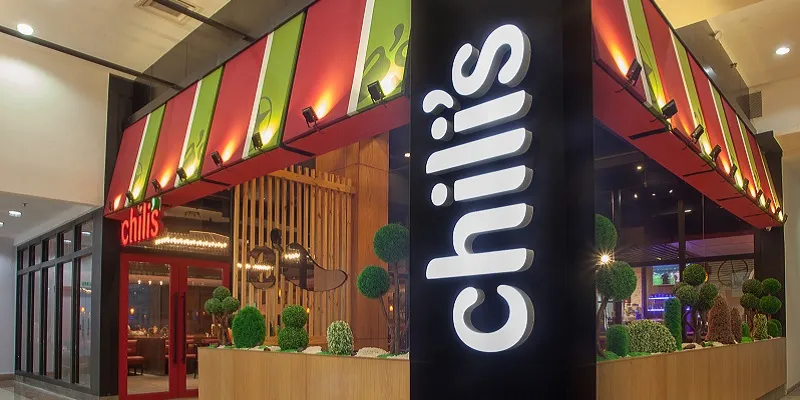This investor-turned-food entrepreneur spiced up Chili’s outlets to serve up a turnaround
Known for its fajitas and burgers, Chili's had seen several ups and downs in India. But that was before Ashish Saxena took over as CEO. In three years, he revamped the food, service and ambience, and grew the revenue to Rs 64 crore in 2016 from Rs 17 crore in 2013.
It was the year 1975. While Paul Allen and Bill Gates were busy building Microsoft, which would transform the way operating systems would be used, Dallas was witnessing a real-estate boom of its own. And while there were many towering skyscrapers being built illin the city, an old post office was being converted into a funky eatery named Chili’s.
When Larry Lavine conceptualised Chili’s, he wanted to create a full-service restaurant with a menu featuring different kinds of hamburgers at affordable prices. Today, there are over 1,600 Chili’s outlets across 33 countries and despite changing hands from Larry Lavine to Brinker International, the brand continues to retain the Southwestern charm of the 1970s.
Much of Chili’s growth into a global brand has been attributed to Norman Brinker, an industry pioneer who has been responsible for the successful operations of Burger King and Haagen-Dazs.
In India, Chili’s is handled by TexMex Cuisine, the development partner of Brinker International, but owned and backed by the TVS Growth fund.

Also read: How this mother-son duo has transformed the meaning of ‘Ghar Ka Khanna’ with The Bohri Kitchen in Mumbai
A new beginning
Chili’s India story, however, is a little different. The brand, which came to Mumbai in 2008, has witnessed revamping and transformation. The idea was to recreate the 1967 magic of Terlingua Chili Cook-off that had inspired Lavine to create a global brand.
In 2009, TVS Capital also invested in Om Pizza, which at that time had rights over Papa John’s and Chili’s in the Middle East and South East Asia. With time, TVS Capital’s stake in the company kept increasing.
By 2012, their stake in Chili’s was close to 85 percent. The team decided to separate Chili’s from Papa John’s, and made it a part of TexMex Cuisine. The idea was that the focus and the capital requirement for a pizza chain to grow and scale was much higher than that of a restaurant like Chili’s.
For a pizza chain to scale, there needed to be over 100 to 150 restaurants to reach decent scale and margins. With Chili’s, the team felt that each unit was capable of being profitable on its own. So in 2013, TVS Capital and subsequently TexMex Cuisine sold off their interest in Papa Johns and set up Chili’s under TexMex Cuisine.
Also read: What made this VC turn into a food entrepreneur with Twigly
From an investor to a food entrepreneur
That was when Ashish Saxena became the chief executive officer. Starting out as techie, moving on to a consultant and later operating partner at TVS Capital, Ashish had decided to venture into the restaurant business with the same mind and tenacity as an investor and a consultant.
The first order of business was to ensure that the food, service and ambience displayed the same taste and feel across the globe.
“Some of the food on the menu was localised. My sense was that if it was a brand with a global presence, then the taste and flavours needed to be exactly the same as what was available across the globe,” Ashish says.
With this in mind, the team went through the process of unlearning, changing the menu and introducing recipes and flavours that were original to Chili’s.
“When I became the CEO, the mandate from the fund was that if we see success and profitability, I would get money for opening more stores,” Ashish says.

But there was an essential and huge hurdle that Ashish had to cross to ensure that Chili's could grow. He realised that independent restaurants always did better than chain restaurants - primarily because the owner is always present in independent restaurants.
“I understood that businesses are profitable because of that and the moment the owner leaves the restaurant, everything starts to crumble. Since we are a chain it was a challenge replicating a model like that as there was no owner,” Ashish says.
Creating an ownership chain
So what they did instead was focus on making the general manager get more ownership and not work as an employee.
Explaining how they worked around that, Ashish says,
“I didn’t go down the path of shares, equity and ESOPS because that is a difficult trajectory. We focused more on culture. It starts with how the GM is made responsible and how he is given responsibility. He or she is given the power to make decisions. That philosophy took us some time to imbibe. But there were always team members who were happy to behave as owners. Now we don’t even have to say it. Everybody knows and says they are owners of Chili’s”
But the task remained an uphill climb. The team had to start with building the company from the ground up. By 2009, Chili’s already had five restaurants, but there was no structure in place. Taking a leaf from his consulting days’ books, Ashish decided to get down in the trenches. He spent two weeks in the kitchen learning how Chili’s was managing all processes in the kitchen.
For the first couple of months, Ashish also spent time in the restaurant interacting with guests and people to get a “feel” of the business. In parallel, he also started putting together a team, including a business head and a head of finance, and moved people around to roles he felt were best suited for them.
Explaining the process, Ashish says,
“The first learning I got was if you have the food, service and ambience right your business will succeed. So, as CEO of TexMex Cuisine, I decided to bring back these three aspects of the business. After reworking the menu, I focussed on improving the ambience. One of the restaurants in Powai, Mumbai, hardly had people coming in. When I investigated I found that the AC wasn’t working. In the Mumbai heat, how do you expect people to visit the restaurant?”

Also read: How Mumbai-based SpiceBox bootstrapped its way to serving over 1 million meals in 5 years
Seeing an upward trajectory
In the next year, the team relaunched the restaurant. Ashish claims they saw a 19 percent growth in the year. The team didn’t focus on growth aggressively because they knew that backend processes needed to be fixed.
The first restaurant with the new management was opened in 2014 end. In FY 2013, the team claims their revenue was at Rs 17 crore. By end of 2016, the revenue was at Rs 62 crore. The team claims to have seen a 3.5 times growth in the past four years and a compounded annual growth rate (CAGR) at 55 percent. The same Store Sales Growth for the past three years is averaging at 11 percent.

However, in India, the restaurant business is booming. According to a Smegers report, between 2012 to 2017, the Indian restaurant industry has seen an annual growth rate of seven percent, pegging it now at Rs 75,000 crores. Of this, in 2017, the organised player space is believed to be at Rs 21,500 crores, showing a 16 percent growth rate.
For a place like Chili’s, it is important that processes make it easy to scale up.
“We chose an ERP for the entire backend, packaging to point of sales. It took us more than two years to implement it. The result was that we were able to stop wastages and leakages in the system from a food-cost perspective. It has added 2-2.5 percent to our bottom line,” Ashish adds.
The future couldn’t appear brighter. Ashish and his team are looking at a revenue of Rs 100 crore by the end of this year, and also plan to grow the number of stores across the country. Cities in West and South India are now on Chili’s radar.







